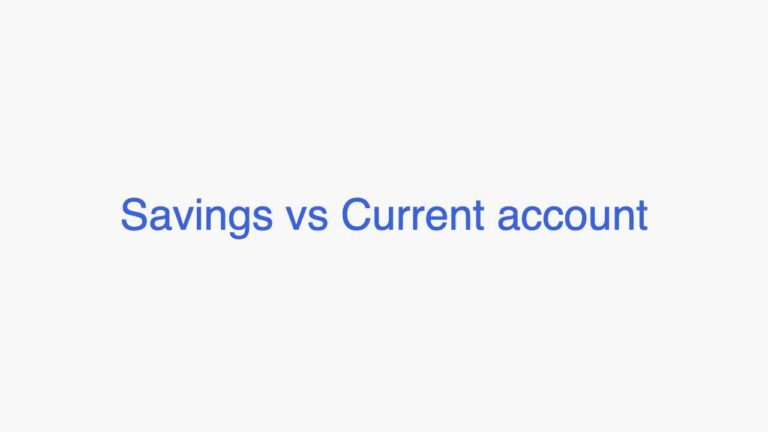Savings vs Current account: Features and differences

When it comes to managing your finances, there are many options to choose from. Two of the most common types of accounts that people use are savings accounts and current accounts. While both of these accounts are designed to help you manage your money, they have distinct features and benefits.
By the end of this article, you will have a better understanding of the pros and cons of each type of account, and be better equipped to make an informed decision about which one to use for your financial goals.
Understanding the definition, purpose, and key features of these two types of accounts is essential to determine which one is right for you.
Definition and Purpose
A savings account is a type of deposit account that allows you to earn interest on your money while keeping it easily accessible. The main purpose of a savings account is to help you save money for short-term and long-term goals, such as a down payment on a house or retirement. Savings accounts typically have lower interest rates than other types of accounts, such as CDs or money market accounts, but they also have fewer restrictions on withdrawals and deposits.
A current account, also known as a checking account, is a type of account that is primarily used for day-to-day financial transactions. The main purpose of a current account is to provide a convenient and accessible way to manage your money, pay bills, and make purchases. Unlike savings accounts, current accounts do not typically earn interest on the money you deposit. Instead, they are designed for quick and easy access to your funds.
Key features
One of the key features of a savings account is that it usually requires a minimum balance, this means you have to keep a certain amount of money in the account to avoid penalties. This minimum balance requirement is meant to encourage you to save money, but it can also be a challenge if you do not have a lot of money, to begin with. On the other hand, current accounts typically do not have a minimum balance requirement, which makes them more accessible to people with limited funds.
Current accounts, on the other hand, do not offer interest on the money you deposit. Instead, they offer other features such as check-writing privileges, debit cards, and online banking. This makes them more convenient for day-to-day financial transactions, such as paying bills and making purchases.
Interest Rates: Comparison of Earnings and Growth Potential
Interest rate is the percentage of interest paid by the bank on the deposited amount. The interest rate is one of the key factors that determine the growth potential of your money.
Savings accounts typically offer higher interest rates than current accounts. This is because savings accounts are designed to encourage you to save money and grow your savings over time. The interest rate on savings accounts can range from 0.01% to 2% depending on the bank and the account balance. Some banks offer tiered interest rates, which means that the rate increases as the account balance grows. This means that the more money you deposit in a savings account, the more interest you will earn.
Current accounts, on the other hand, do not typically offer interest on the money you deposit. This is because current accounts are designed for quick and easy access to your funds, rather than for earning interest. Some banks may offer a small interest on the current account balance but it’s usually very minimal compared to a savings account.
It’s important to keep in mind that interest rates can vary from bank to bank, so it’s essential to shop around and compare rates before opening an account. Additionally, interest rates are affected by overall economic conditions, they may fluctuate over time, so it’s important to keep an eye on the interest rate of your account.
When it comes to growth potential, savings accounts offer a better opportunity for your money to grow. The interest rate on savings accounts may be small, but over time, it can add up to a significant amount. For example, if you deposit $10,000 into a savings account with a 1% interest rate, after one year, you would earn $100 in interest. This may not seem like a lot, but over time, the interest earned can add up, especially if you make regular deposits into the account.
Current accounts, on the other hand, do not offer much growth potential for your money. They are designed for quick and easy access to your funds, rather than for earning interest. As such, if you are looking for a place to grow your money over time, a savings account may be a better option.
Accessibility and Liquidity: Differences in Withdrawal Limits, Transactions, and Fees
When it comes to accessibility, savings accounts have certain withdrawal limits and transaction limits. This means you can only make a certain number of withdrawals or transfers per month. This is meant to encourage you to save money and discourage you from using your savings for everyday expenses. Some banks may also impose penalties for exceeding the withdrawal limits, which can be costly.
On the other hand, current accounts usually do not have withdrawal limits, which makes them more convenient for day-to-day transactions. They are designed for quick and easy access to your funds, which is perfect for paying bills, making purchases, and managing your day-to-day finances. Additionally, current accounts usually offer check-writing privileges, debit cards, and online banking which makes it easy for you to access your funds.
When it comes to liquidity, savings accounts are less liquid than current accounts. This means that it may take longer to access your money and use it for transactions. With a savings account, you may have to wait for a certain number of days or even weeks for a withdrawal or transfer to clear. On the other hand, current accounts are highly liquid, which means you can access your money and use it for transactions almost instantly.
Eligibility Criteria and Requirements for Opening
When it comes to opening a savings account, the eligibility criteria may vary from bank to bank, but generally, you will need to provide personal identification, such as a government-issued ID or passport, proof of address, such as a utility bill or lease agreement, and a minimum deposit to open the account. Some banks may also require a co-signer or a reference if you are a student or a first-time account holder.
When it comes to opening a current account, the eligibility criteria may vary from bank to bank, but generally, you will need to provide personal identification, such as a government-issued ID or passport, proof of address, such as a utility bill or lease agreement, and a minimum deposit to open the account. Some banks may also require a co-signer or a reference if you are a student or a first-time account holder.
Conclusion
Savings and current accounts are both important tools for managing your money, but they serve different purposes. Understanding the key differences between the two, such as interest rates, accessibility and liquidity, eligibility criteria, and suitability, can help you make an informed decision on which account is the best fit for your financial goals and needs.
Can I have a savings and a current account at the same time? Yes, there is nothing under the law that stops bank account holders from having multiple accounts.
Which is better, Savings or a Current account? The determinant of which is better is dependent on the intention of the account to be used. Check out the features and draw up the best account for you.
Don't miss a thing. Follow us on Telegram and Follow us on WhatsApp. If you love videos then also Subscribe to our YouTube Channel. We are on Twitter as MakeMoneyDotNG.





